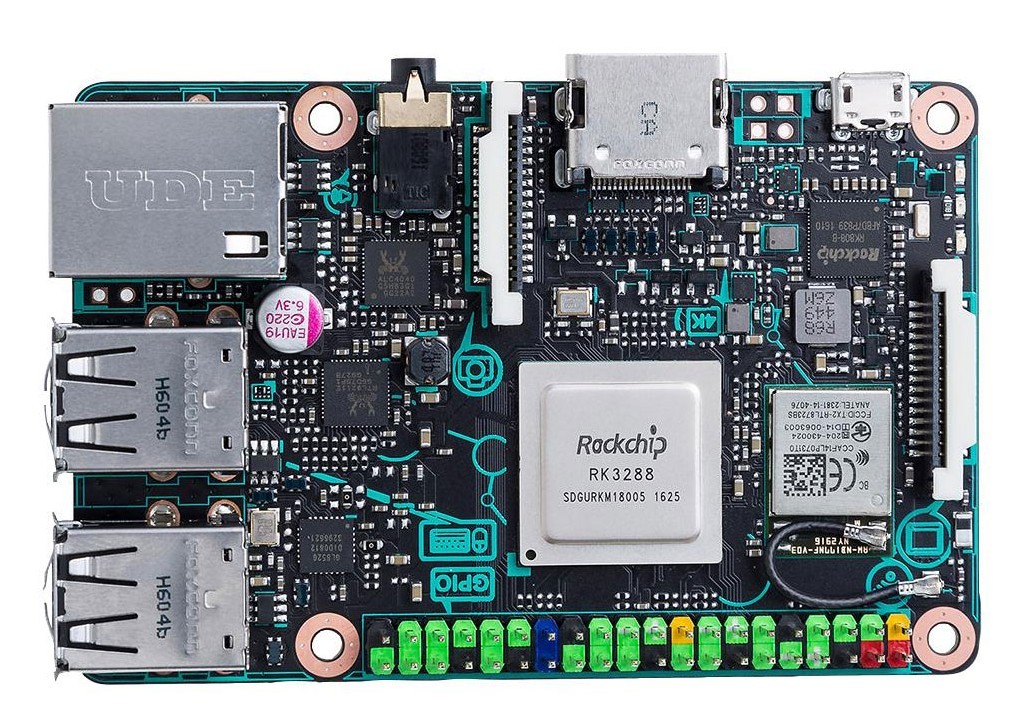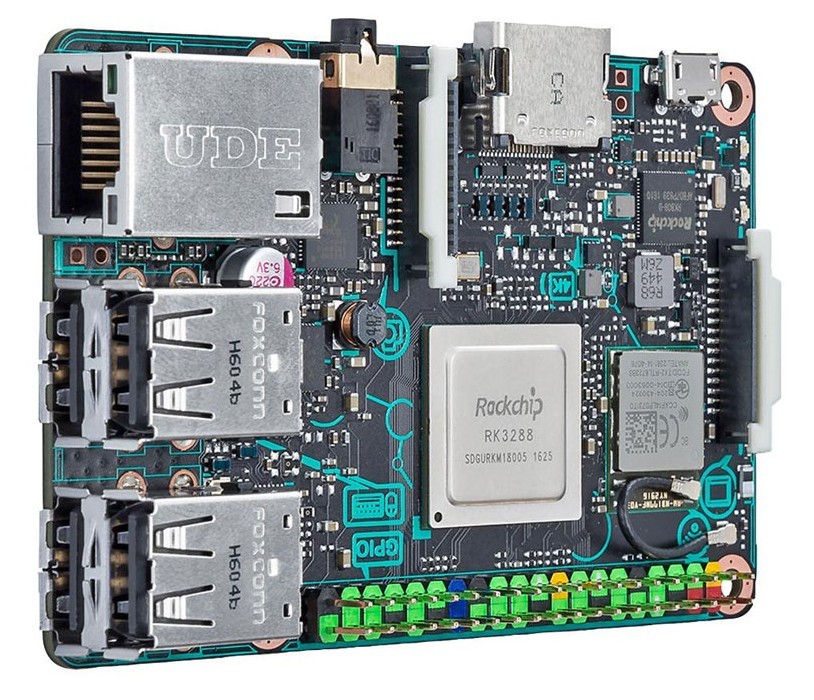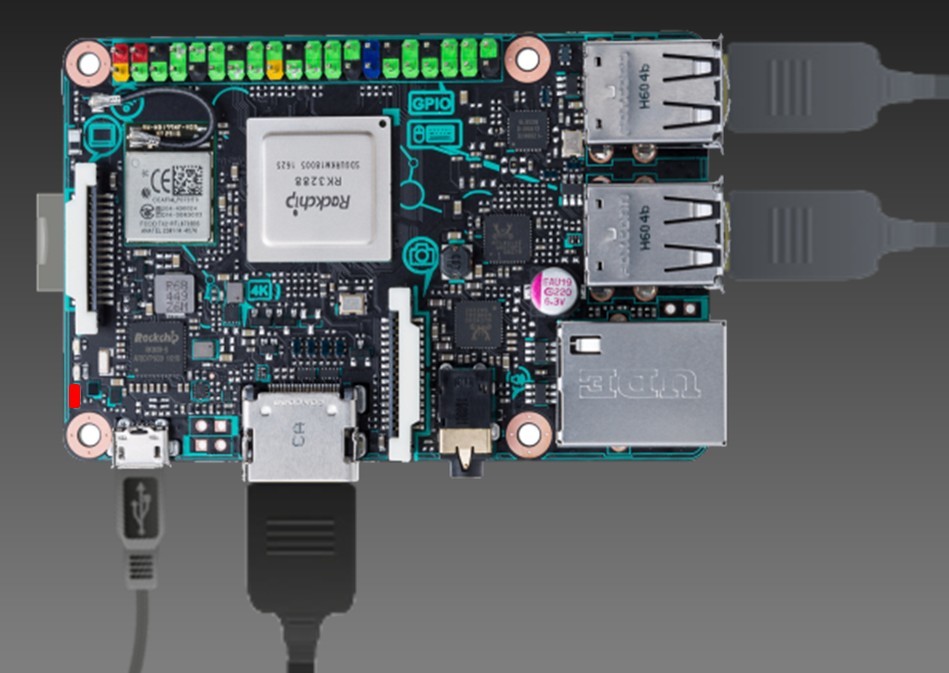ASUS Tinker Board: another RPi competitor

In the regiment of competitors Raspberry Pi arrived. Although the new Tinker Board from Asus can hardly be called a real competitor, because this board is of a different level and at a much higher price. The Tinker Board costs about $ 68, which is almost twice as expensive as the Raspberry Pi 3 ($ 35), which has been on sale since February 29, 2016 .
But for this money you get a much more powerful ARM Cortex-A17 with a clock frequency of 1.8 GHz, gigabit Ethernet, HDMI 2.0 support for monitors and TVs with resolutions up to 4K and H.264, 2 GB of memory, 192K / 24 bit sound instead 48K / 16 bits for RPi, SDIO 3.0 and some more bonuses.
Asus Tinker Specifications
- Processor : Quad-Core 1.8 GHz ARM Cortex-A17 (Rockchip RK3288)
- GPU : ARM Mali-T764 GPU with support for OpenGL ES1.1 / 2.0 / 3.0, OpenVG1.1, OpenCL, DirectX11 (note: this SoC with this GPU is used in some virtual reality helmets )
- Memory : 2 GB Dual channel LPDDR3
- Connectivity : Gigabit LAN and Bluetooth 4.0 + EDR
- Wi-Fi : 802.11 b / g / n with replaceable antenna
- USB : 4 USB 2.0 ports
- Expansion Interfaces : 40 pin contacts, including 28 GPIO
- Contacts for PWM and S / PDIF signals
- Sound : RTL HD codec, 3.5 mm audio jack
- Camera : Camera Serial Interface (CSI) connector for camera connection
- Display : 15-pin Display Serial Interface (MIPI DSI) connector with support for HD resolution
- Display : one HDMI 2.0 port with support for resolutions up to 4K
- External memory : a slot for flash cards Micro SD with support for UHS-I
- Operating system : Debian OS / Kodi
- Power supply : 5V / 2A Micro USB (cable not included). Maximum power consumption - 5 watts. In idle mode with HDMI - 2.25 W, without HDMI - 2 W

A little more technical information can be found in the Slideshare presentation .

For example, here is the functional purpose of 40 contacts. Apparently, this pinout is compatible with RPi. Various expansion modules that are commercially available from ADAFruit, SPARK FUN, SEEED STUDIO, etc. are connected to that motherboard.

Externally and in size, the Tinker Board resembles RPi: there are also four USB, HDMI, Ethernet ports, although a different color of the board is immediately noticeable, another processor and other features. Here, the Ethernet chipset supports the gigabit interface, as opposed to 100 Mbps on the RPi.
According to the benchmarks Geekbench 3presented in the presentation, Rockchip RK3288 from the Tinker Board shows almost twice the best result than Broadcom BCM2837: 3925 against 2092. True, these results still need independent verification.

With the same SanDisk ExtremePRO UHS-I 128GB flash card, Asus motherboard demonstrates faster read and write speeds.

At first glance, it seems that Tinker Board is “sharpened” for home theaters and multimedia applications. Probably, on this board you can assemble a home multimedia "box" more functional than on the basis of RPi.
The above presentation shows typical usage scenarios. Here is what is proposed to do on its basis:
- A laptop
- Phone
- Portable game console
- Portable camera
- Digital wall calendar
- Slot machine
- Robotics products (multicopter)
- Mini pc
The board is positioned as a training material for studying electronics and programming, as a DIY maker tool, as well as for the manufacture of industrial applications and IoT devices.
In the British shop Farnell, the board is sold for £ 45.83 (£ 55.00 including VAT). In terms of dollars, this is $ 56.74 ($ 68.09 with VAT). In addition to the board itself, the package includes a radiator for the CPU and nothing else. Separately, you will have to buy a cable for power, a flash card, an HDMI cable and everything else, if necessary - a monitor, keyboard, mouse. After buying all the necessary computer boot will be easy. It is enough to connect all the peripherals, insert the SD card with the operating system boot image - and turn on the computer.

Asus Tinker Board joins the number of numerous clones of Raspberry Pi that appeared five years after the release of the first version of the “raspberry” on February 29, 2012. Some competitors introduce their own form factors, but most try to maximize copy the original hit, developed by engineers from Cambridge. They make the board as close in size as possible with a nearly identical set of interfaces as possible.
Tinker Board sizes: 3.37 "× 2.125", i.e. 85.6 × 54 mm.

Among the competitors RPi dominated by little-known manufacturers, so that the new product from Asus stands out among them. Interestingly, this fee was not presented officially, the company did not issue a press release. Tinker Board just quietly appeared in the store.
At the moment, the site of the store indicated that there are 16 cards left in stock. From Farnell, by default, delivery is only available within the UK; for overseas orders, you need to contact an Export Specialist (Export Coordinator) by email. According to rumors , sales in the United States will begin on January 30.
